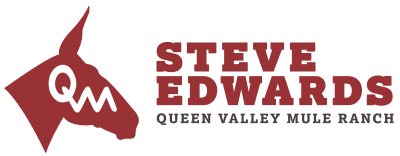Mule & Donkey Saddle vs Horse Saddle
When you use a horse saddle on a mule you will hurt your mule.
In this video Steve Edwards of Queen Valley Mule Ranch explains the differences in a mule saddle vs a horse saddle and exactly why you need to buy a saddle that is designed to fit that skeletal structure of the donkey or the mule.
Steve Edwards: Hi, my name is Steve Edwards, and welcome to Queen Valley Mule Ranch. Here at the ranch we’ve been training mules for the past 20 years, educating the mule and the mule rider, also the donkeys, they’ve become super-popular. One of the big things that’s very, very important to Mr. Mule and Mr. Donkey is this, the equipment that’s going on their back and going in their mouth and in their head. Extremely important that this equipment fits correctly. I have a lot of people that keep asking me the same questions, and I keep answering the same way. They say, “How can your saddle fit every mule that you’re talking about?” I simply say, “We got to remember it this way, the mule has the donkey bone structure.” Because of the donkey bone structure, I go by donkey skeletal structure, not muscle mass.
The problem with muscle mass, you watch, within a weekend ride we can conceivably lose 100 pounds, so what are you going to do? Keep adding pads? Then you got to make cinches tighter, and then you’re going to have your saddles roll. The closer your tree sets to the mule’s back, to your donkey’s back, the better. That’s what’s really important. If it’s setting on that donkey’s back, if it’s setting on that mule’s back correctly it’s going to make a big difference.
Now, the skeletal structure, on a donkey they’re V-shaped in their shoulders. Horses are A-shaped in their shoulders. That’s why a saddle goes back on a horse, forward on a mule or donkey. Since they’re V-shaped in their shoulders that saddle wants to slide forward. The other thing is their scapula goes up and down, up and down like pistons, where horses go horizontal. Right in behind the scapula is kind off of a cup, and then there’s a fat pocket, so there’s two places we don’t want to restrict. We don’t want to restrict the scapula because it’s going up and down. We don’t want to restrict this area in here because it moves around a lot. Watch your mule, watch your donkey, watch this motion that you’re going to be seeing, and imagine your saddle putting pressure into it. Now, they also carry weight down low where horses carry their weight up high.
That’s just the basics. What I do is I take the spine, and I measure 7/8 of an inch from the center of my spine to each one of the edges of my bars. By doing that I’m going to be setting up on top of muscle mass. I’m not going to be setting on the skeletal structure at all, and I’m not going to be setting on a fat pocket. That’s the other thing we have to think about. When we go wider there are semi-quarter horse, which is what this tree is, and then there’s full quarter horse bars, which is a wider tree. When you go wider you get up on the fat pocket, which is on the 6th and 7th rib, which is right where you do your cinching. So, when you pull that down that high spot is going to be pressed on, and you can do something as easy as knock out a rib, very simple. Using skeletal structure of the donkey that’s on that mule, and then I can use the same saddle on the donkey, is how I go by my fit.
Here’s the thing what you want to consider, a lot of your saddle makers, they come out, and they measure your mule in January. All right, we’ve got a mule measured in January where he’s fat and sitting around. Then we take and we measure him again in July, maybe August where he’d been ridden, he’s toughened up, doesn’t have quite the fat, you’re going to have a different measurement. The folks that are telling you to take measurements, they’re great saddle makers, they do a good job, but they don’t understand working mules and donkeys on those trails. They don’t understand spending several days in the trail. If they would there’s a lot of things they would change if they understood the bone structure and the muscle mass and this sort of thing of those mules and donkeys.
They tell you to get four wires, put one wire on the wither, one wire behind the scapula, one wire to center the back and one wire in the back. Well, that’s all well and good, but, there again, if we do that in January we’re going to have one fit. We do it in July, August we’re going to have a different fit.
Let’s look at this, this tree that I have here, this saddle stand, is a horse saddle stand. This saddle that I have here is semi-quarter horse. I want you to notice how it fits all the way across, it’s tight here in the back, this is your kidney area, all right? This is your scapula area, right here is your scapula that goes horizontal on a horse, up and down on a mule. Then right in behind here, there’s kind of a pocket area, and that area moves around a lot. Watch your mule, watch your donkey. As you see them walking you’ll see that area moving. If you tighten that front cinch, you put pressure up on that area you are restricting that movement. That’s where you get your white hairs. That’s where you’ll bet your dry spots because you overtightened that front cinch.
White hairs is not a problem. White hairs is just a, “Hey, you better listen to me.” White hairs is a scald. It comes from several things, one, the restriction of that bar. Two, the type of saddle pad that you’re using, and, three, you’re not taking and tightening that back cinch. Now, notice again how this thing fits pretty darn nice all the way across on this horse tree, or this horse saddle stand. That’s what that looks like.
When we take my tree, and it’s been very consistent for a lot of years, I want you to notice that right off the bat if I just lay it here it sticks real high in the back, and it goes in the scapula. The way I designed it is as soon as you sit down or tighten the back cinch the pressure comes up off of the scapula. Now I can run my hand underneath here. I am not impeding, I am not restricting that area, and I’m not on a scapula where it’s going to be hitting, all right?
You see that? A lot of people will take and do this and say, “Oh, that don’t fit.” You’re not sitting on the horn, you’re sitting here. When you sit here it takes the pressure up off the scapula and off that area. Now, notice the other thing is I’m not sitting down against the kidneys.
Heres the downside, folks, that’s muscle mass, and your kidneys are hanging. When this constant pressure is beating against those kidneys, you’re going to have something called azoturia set in, and it’s not a pretty sight to see one die of azoturia. What it amounts to is is the muscle gets pounded and pounded and pounded. Then they eat, and they eat a lot of high-carbohydrate feed, and then them kidneys can’t handle it. The kidneys start poisoning the system, and your mule shows what looks like cholic, but it’s called azoturia.
With my tree, you can see here, this is a horse saddle stand. I’ve sat my saddle back two and a half inches behind the scapula. Here’s my scapula. I set it back two and a half inches. I don’t sit on top of the scapula so that I’m getting this. I move it back behind the scapula, and then I tighten the back cinch. It comes up off of that working area, which you can’t do that with this saddle, and then I don’t have the pressure back here up on the kidneys. I’ve got about more than three-quarters of my saddle sitting on the animal’s back on muscle mass. You do not have to have every piece touch on that animal’s back. If it does, as I just told you, kidney problems, restricting muscle.
Let’s just take a look at this. Look at most of your saddles. People want to use one cinch, “Oh, we don’t want to tighten the back cinch. That’s a bucking cinch.” No, no, there’s a reason for that D-ring back there, and I’ll talk to you more about other saddles and stuff, but that D-ring is to keep you from doing this. When you take and tighten up that front cinch, now the back of this saddle comes up. You’ve got the front of this cinch tightened up, and as you’re sitting you’re doing this. Look what the pressure you’re putting here. Why do you have white hairs here, why is it dry? Because we’ve restricted this area, and we don’t have that back cinch.
That back D-ring is important. On a mule the back cinch needs to be tightest, the front cinch needs to be loosest. On a horse, front cinch tightest, back cinch the loosest. That way you keep it from doing the cantilevering. People are sitting in the saddle, this is why it’s going down the road, it’s doing this. No wonder your horse is having problems, if you’ve got standards low enough to ride a horse. No wonder your mule is having problems, and no wonder your donkey’s having problems. We all deserve to get bucked off, and I’ve got 32 broken bones and two replaced hips because I didn’t listen.
Now, want to listen? Here it is, you can see the picture. Any of my clinics, any of my expos I bring trees, I show you. I want you to see when you tighten up that front cinch look what you’ve got. That’s what you’ve got, horses, mules, donkeys, especially when you’re using a horsey tree. Semi-quarter horse bars are the most-used bars on every single saddle. I don’t care what saddle company you go to, they all use the direction of semi-quarter horse. The quarter horse is the center, actually, of the equine world. A lot of people don’t want to believe it, but it is. It has set the standards.
Semi-quarter horse the narrower, full quarter horse the wider. When you go wider up on your mule you are going to have problems up on that 6th and 7th rib, on that fat pocket. So, that is the semi-quarter horse tree that you’re putting on your mules to fit your horses. Here’s my tree. As soon as you sit in it, as soon as you tighten up the back cinch you can see it comes up off the animal. There’s no pressure on the kidneys, so I’m not developing any problems there. There’s no pressure up here in the scapula area. There’s no pressure there. Right where I’m sitting, that’s where my saddle needs to fit, not firm all the way across putting pressure points everywhere. You have to have pressure somewhere, and I’ve got it there. Now, that helps you with the trees. That’ll give you a pretty good idea. Hope to see you in some other videos. I’ll show you how I come about making the Steve Edward’s Queen Valley Mule Ranch mule saddle.
- Posted in: Everything, Videos
- Tagged: Everything, Videos


